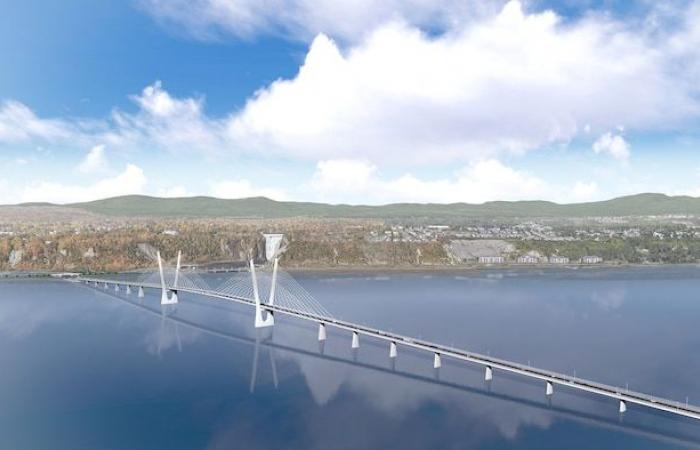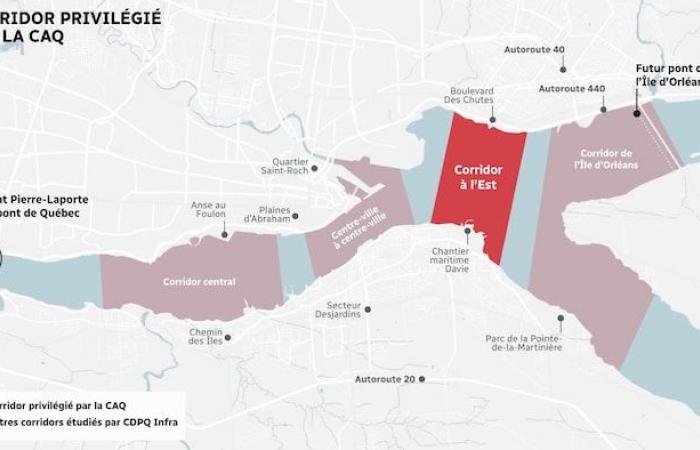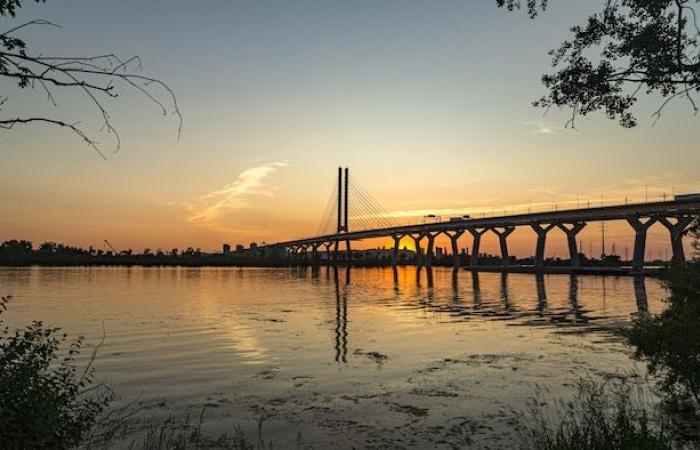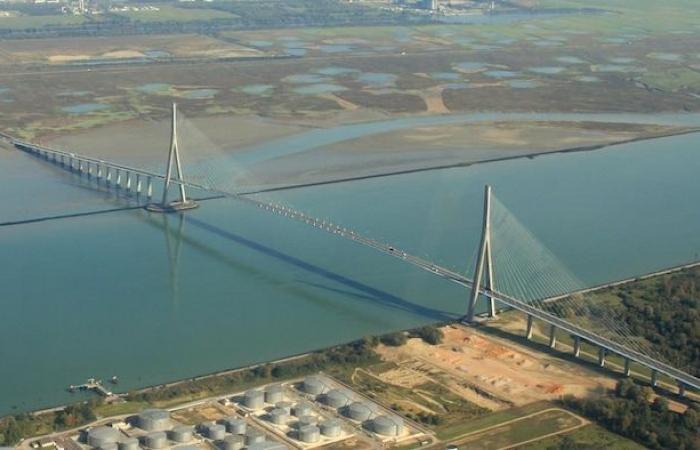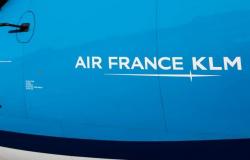“Difficult to think” that a third link in the east of Quebec and Lévis, in the form of a highway bridge, would cost less than “8 to 10 billion” dollars, estimates engineer Bruno Massicotte.
Affiliated with the department of civil, geological and mining engineering at Polytechnique Montréal, Professor Massicotte bases his estimate by comparing the Coalition Avenir Québec (CAQ) project to projects recently carried out or underway in the province.
He immediately mentions the new Île d’Orléans bridge, the construction of which was officially confirmed last spring at a cost of $2.7 billion, a higher bill than expected for a shorter and less imposing section. . Total expenses will only be known at the end of the day, while the inauguration of the bridge must take place in 2028.
Open in full screen mode
Preliminary sketch of the future Île d’Orléans bridge
Photo: Government of Quebec
Mr. Massicotte then mentions the Samuel-De Champlain Bridge, in Montreal.
Opened in 2019 and built in 2015, the work cost a total of $4.47 billion in a more favorable economic context, before the pandemic. Evoking a size and length similar to what would be necessary for the Quebec project, the expert sees it as a relevant comparable to determine the bill for the third link.
It would be hard to think that it would be less than 8 to 10 billion in today’s dollars
he assessed in an interview with Radio-Canada. This amount is close to the $9.5 to $10 billion estimated for the tunnel project abandoned by the Coalition Avenir Québec (CAQ) in 2023.
Open in full screen mode
The eastern corridor, favored by the CAQ, in comparison to the other corridors studied by CDPQ Infra.
Photo : Radio-Canada / Olivia Laperrière-Roy
The river, in the corridor determined by the CAQis 3 kilometers long alone, which is approximately the same width as the Champlain Bridge in Montreal. Including the accesses, the third link to the east could in all likelihood have a length similar to the 3.4 kilometers of the Montreal bridge.
As in the metropolis, Mr. Massicotte would favor a cable-stayed bridge in the capital.
The height of the deck could, however, be greater in Quebec. Unlike Montreal, the capital welcomes large cruise ships, some of which require a clearance of nearly 70 meters under a structure.
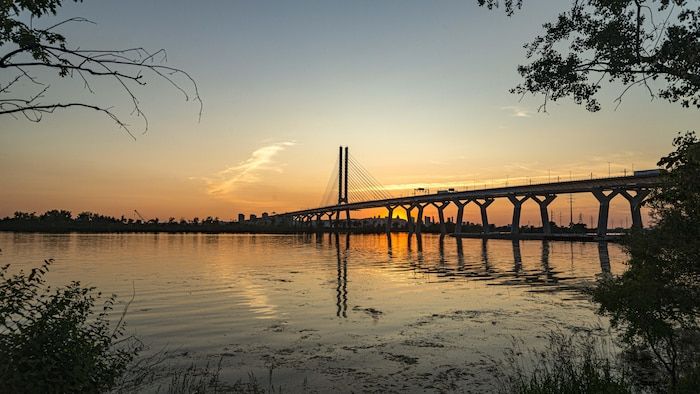
Open in full screen mode
The Samuel-De Champlain Bridge has a size similar to a possible third highway link, although probably less than what would be necessary in Quebec. (Archive photo)
Photo : Radio-Canada / Daniel Thomas
At least twice the island bridge
Being motorway, a third link would have at least four lanes of traffic
notes Mr. Massicotte. It would be so, when leaving
twice as wide as that of Île d’Orléans. A possible Quebec–Lévis bridge would also be a little longer and much higher
in order to cross the St. Lawrence Seaway, which passes closer to the south shore.
The Île d’Orléans bridge only has to span a secondary channel, to the north, where the size of the ships passing underneath is lower than those of the seaway.
Quebec is one of the most beautiful cities in North America. But it’s beautiful because the geography is special. […] It’s steep. This makes any surface transportation development difficult.
According to Bruno Massicotte, pronounced slopes and long approach ramps would necessarily be necessary to ensure that the required height (nearly 70 meters) is reached once at the apron, otherwise cruise traffic could be compromised. If the slope is 3 to 5%, it will be necessary up to 1.4 kilometers
to reach the desired height, he calculates.
If cruises were sacrificed, the structure would then have a clear height of at least 50 meters to allow merchant ships to pass.
A large clearance between the pillars of the deck would also be necessary, he continues, in order to allow boats to pass simultaneously in both directions of the waterway. This clearance could be at least 650 meters, again according to Mr. Massicotte.
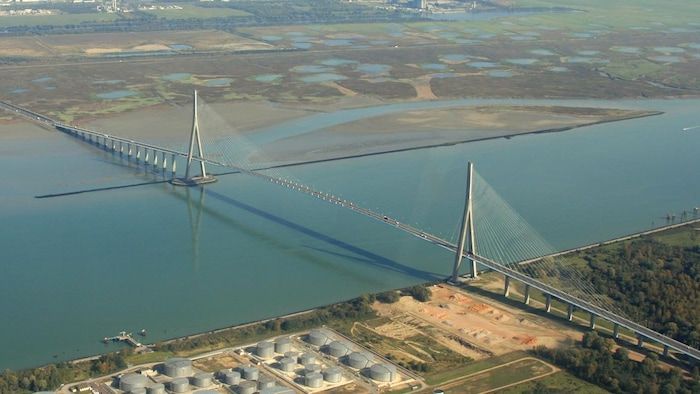
Open in full screen mode
Such a size necessarily means costs. Higher piles generate greater forces, both for wind and earthquakes.
he emphasizes. The distance between the pillars and the depth at which they must be fixed will also influence the amount of the invoice.
We know that the ground at river level, at least for the northern half, is made of deposits which are not very conducive to construction.
he said on this subject. The same challenge was observed for the Île d’Orléans bridge.
First choice
to the west
Bruno Massicotte is not his first outing on the third link, having also signed reports commissioned by the former Liberal government and that of the Coalition Avenir Québec.
Son first choice
would stop on a bridge built in the same place as the Quebec and Pierre-Laporte bridges, in the western sector of the city. He advocates the construction of a new structure for the same reasons as the CAQcriticizing the lack of redundancy
inter-river links in the region.
He is also campaigning for a bridge-tunnel project – his second choice – linking Saint-Romuald to Quebec, via a bridge over the river then a tunnel giving access to arteries such as the Robert-Bourassa highways and Charest Boulevard.
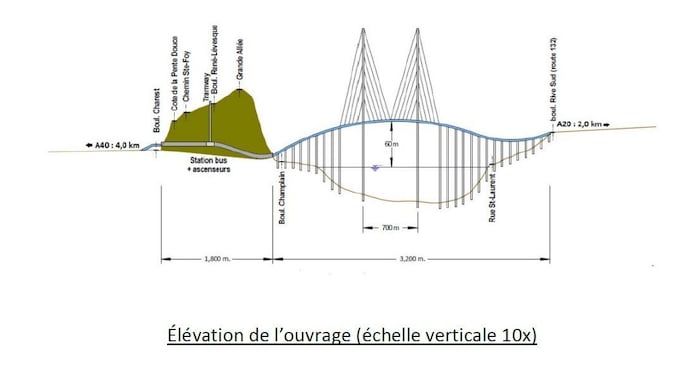
Open in full screen mode
The structure would be a cable-stayed bridge with a span of approximately 700 meters and would have six lanes, three in each direction.
Photo: Courtesy
Updated this fall
This estimate from Professor Massicotte comes at a time when the Quebec government has promised an update of its project this fall.
Last June, Prime Minister François Legault (re)made the commitment to build a highway link
between Quebec and Lévis, in particular to guarantee economic security
of the region. This time, the government’s choice fell on the eastern corridor.
This promise was made despite the contrary advice of CDPQ Infra, mandated by Quebec to evaluate inter-river mobility in the metropolitan region. According to his report, nothing justifies a motorway link between the two banks. CDPQ Infra instead proposed a tunnel under the river, dedicated to public transport, from city center to city center.
The report noted marginal gains in mobility for the territory
of the Metropolitan Community of Quebec. These gains cannot, on their own, justify the construction of a new inter-river road link
.

